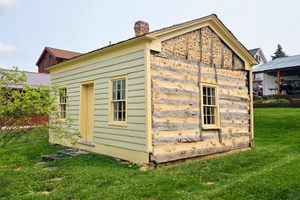
"Imagine yourself in 1827 … Winter approaches. You are cold and hungry in a strange land… Your priorities: food, shelter, and smelting lead for income to stay alive."
So begins the Iowa County Historical Society's introduction to the Dodge Mining Camp Cabin. Through this log cabin, which is the oldest building in the county, you can experience the hardships and betrayals of the earliest Wisconsin lead miners.
Both the cabin and the city of Dodgeville are named for M. Henry Dodge, a man whose rapacious desire for wealth and power typified the era. In the early 19th century, the area belonged to the Ho-Chunk Nation. The Ho-Chunk and other Indigenous nations had mined the area for lead for centuries, often selling to French and American traders. Lead, at the time, was most valuable for paint, and was increasingly valuable as a source of ammunition. In 1822, the United States government claimed the area through a spurious treaty signed with a rival tribe, and began opening up the land for leasing, and white miners began to pour in, seeing an opportunity to take advantage.
Dodge, a veteran of the War of 1812, was leaving Missouri on the heels of debt collectors seeking the then-astronomical figure of $15,000. In 1827, when he arrived, the Ho-Chunk Nation had begun to take up arms under their chief, Red Bird. Red Bird was frustrated by the constant claim-shopping and illegal settlement of Ho-Chunk land, and was devastated by a false rumor that soldiers at Fort Snelling had hacked apart two Ho-Chunk prisoners. Dodge led a volunteer army against the outnumbered Red Bird, perhaps to protect his own mining holdings near Galena. After Red Bird was captured and sentenced to death, the land rush was on.
Dodge moved his camp northeast of Galena to the city that now bears his name. This land was still claimed by Ho-Chunk Nation, but also by a competing miner, Ezra Lamb. He refused to acknowledge the claims, instead quickly building a stockade and a few log cabins, including the one that stands today. His only legitimacy was what miners called "a buckshot claim," according to author Lawrence D. Sundberg, referring to the barrel of a gun. Still fleeing outstanding debt, he would maintain his claim regardless of any competing authority.
Dodge’s Camp consisted of about 100 miners, including his family and five enslaved people, Toby, Tom, Lear, Jim, and Joe. These five miners were promised emancipation if they worked for a year at his smelter. True to form, Dodge would go back on his word, enslaving them for an additional 12 years, even though slavery was illegal in the region. The five workers would finally be freed in April 1838. (Dodge would eventually come to support the abolition of slavery.)
The camp would be short-lived, however, as in 1829, the price of lead plummeted. The area was nearly abandoned. Soon after, the Black Hawk War of 1832 began, pitting white settlers against a number of remaining tribes. Black Hawk would surrender, fleeing for safety across the Mississippi River. Henry Dodge would lead forces to chase the fleeing army, shooting down stragglers who had already surrendered.
Dodge may have been a bloodthirsty cheat, but he found common cause with a like-minded individual, President Andrew Jackson. When the Wisconsin Territory was founded in 1836, Dodge would become the territory’s first governor. And with the area cleared of Indigenous peoples, white miners would once again flock to the area, and Dodge’s Camp, now known as Dodgeville, began to thrive.
These miners, many from Cornwall and Wales, produced millions of pounds of lead in southwest Wisconsin. The miners would burrow holes into hillsides to collect the plentiful lead, earning the nickname “badgers.”
The cabin itself would become a piece of Dodgeville. It was first renovated in 1842, and would become a private residence for more than 100 years. In 1967, it was acquired by Iowa County notary public Ken Palzkill, who would turn it over to the historical society in 1987. It was moved to its current location in 1998, and would join the National Register of Historic Places in 2005, due to its unique architecture.
Today, the cabin stands as a memorial to southwest Wisconsin’s mining history. Visitors can tour the settlement-era "log pen house," one of the few remaining in Wisconsin. It has been restored to its 1842-1850 appearance, but one wall is exposed to show the original cabin. Through interpretation, you can think about the deception, violence, and hard work that led Dodgeville to become "badger country."

Post a Comment